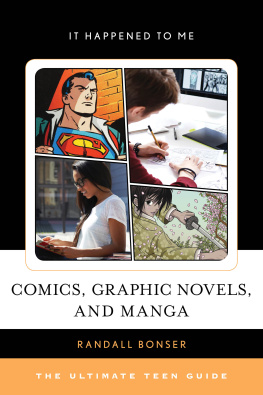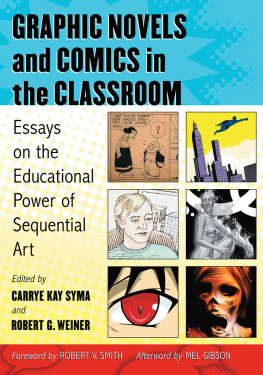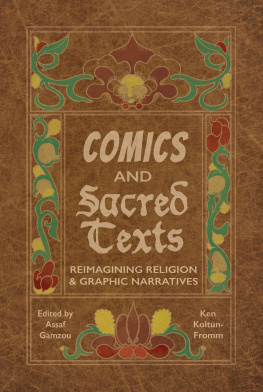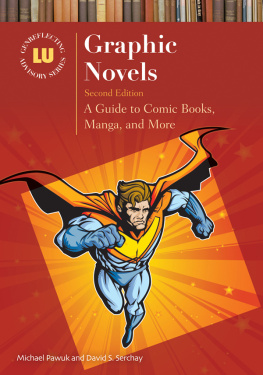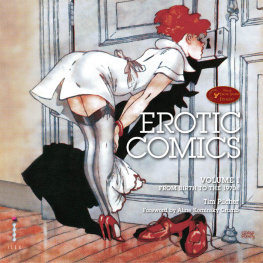On the Graphic Novel
On the
Graphic Novel
Santiago Garca
Translated by Bruce Campbell

www.upress.state.ms.us
The University Press of Mississippi is a member of the Association of American University Presses.
All cartoons, comic strips, and drawings herein are used for analytical, critical, and scholarly purposes. Some are in the public domain; others are protected by copyright but are included here under the provisions of Fair Use, an exception outlined in Section 107 of United States copyright law.
Text copyright 2010 by Santiago Garca
Preface copyright 2010 Juan Antonio Ramrez
Spanish edition 2010 Astiberri Ediciones
English translation copyright 2015 by University Press of Mississippi; published by arrangement with Astisendo grupo editorial S.L.
All rights reserved
Manufactured in the United States of America
First printing 2015
Library of Congress Cataloging-in-Publication Data
Garca, Santiago, 1968 author.
[Novela grfica. English]
On the graphic novel / Santiago Garca ; translated by Bruce Campbell.
pages cm
Includes bibliographical references and index.
ISBN 978-1-62846-481-8 (hardback) ISBN 978-1-62846-482-5 (ebook) 1. Graphic novelsHistory and criticism. 2. Comic books, strips, etc.History and criticism. I. Title.
PN6710.N6813 2015
British Library Cataloging-in-Publication Data available
To my father
Contents
Preface to the American Edition
After La novela grfica
Five years ago, I published this book in Spain for the first time. My goal, as stated in the introduction to the original edition, was to learn about being a cartoonist during a time in which I felt the scenery was changing so fundamentally that nobody was quite sure what comics were and where they were leading us.
La novela grfica fulfilled that goal for me. And it now helps me navigate these later years of my comic-writing career. After finishing it, I felt I had a grasp of where I came from and a clearer idea of the path I had set upon. It is with pleasure then, that I come back to this book to introduce it as On the Graphic Novel to a new audience, to those of my adopted country. I have lived in the United States for the past three years, and I think I have come to know firsthand the condition of comics in America and to better understand how the reception of this book will differ from the reception it had in my own home country.
I will therefore seize this opportunity to write a new introduction to On the Graphic Novel to approach two different sets of questions. Firstly, I will try to answer some of the more controversial aspects of this work that readers have presented to me during these past few years; secondly, I will write down some notes on how the graphic novel phenomenon has changed during the period subsequent to the original publication of the book.
One of the gripes that I have encountered most is that On the Graphic Novel does not present a clear-cut and precise definition of just what kind of thing a graphic novel is. Mostly, the critics understand a definition to be a set of formal parameters that unambiguously trace the shape and size of the graphic novel versus other, different kinds of comics. But while the graphic novel is another, different kind of comic, it is more properly another, different formulation for comics. The obsession with a definition has been since its inception an albatross around the neck of the study of comics, bent on restarting the work from the ground floor. Like Sisyphus, comics scholars feel that they have to personally do it over again every time they approach the field. Usually, they feel the obligation to roll the unbearable boulder, and to review and judge the relative merits of ancient forefathers like the Egyptian pictograms, the Trajan Column, and various illuminated manuscripts before inevitably coming to the conclusion that our beloved art form does not properly begin until the arrival of Rodolphe Tpffer and/or The Yellow Kid. Then, typically, they top it off trying out some kind of partial, controversial and easily contested definition. These definitions usually attend solely to expressive features and semiotic concerns, but fail to acknowledge the basic material elements pertaining to a distinct art form- something that cannot be overly stressed when the discipline in which the study is inscribed is History of Art, as in my case.
This is why I am not interested in a regular definition of comics or, fine, be that way, the graphic novelwhich really has no a priori stylistic features; but, instead in placing
And this is the question that this book answers: not what comics are, not what the graphic novel is, but rather what the meaning of comics for us was, what it is now, what different functions comics have performed in our society and culture, and how the idea of the graphic novel is related to that.
With this approach, we find the concept of the graphic novel deep-seated in the institutional swing taking place over the last few decades, as the traditional publishing industry crumbles. This disintegration has been a universal phenomenon, but it is more clearly observable in Spain than in America, where the leftovers of an industry based on old-time superheroes cling to the illusion that traditional comics are the mainstream, while adult comics and art comicsi.e. the graphic novelare alternative. In Spain, our local traditional publishers fell apart around 1986, and by the end of the nineties nothing that resembled any kind of commercial industry remained. During the last twenty years, mainstream comics in Spain have meant American and Japanese imports. And Spanish comics have had to reinvent themselves from the ground up, finally finding a proper venue in the advent of the graphic novel, especially from 2007 on. These were the circumstances that moved me to research graphic novels, and this explains why it has been easier to observe this international land shift in comics from Spain than from the United States, which is perhaps more caught up in the internal dynamics of a highly polarized market.
To
Jenkins reminds us that a mediums content may shift, and in his listing of such media, subjects to broach, but oftentimes it returns to its comic roots in order to satisfy demands born of authorial anxieties, commercial needs, or even pure nostalgia.
There is a second battle into which On the Graphic Novel has been dragged. A whole current of scholars and critics consider the graphic novel an instrument for legitimating comics by discrediting the comics that came before. The graphic novel though could hardly be accused of affecting the reputation of traditional comics: you cannot really discredit that which never had any cultural credit in the first place. Indeed, we could go so far as to say that the worst enemy of comics has always been the comic industry, which for a whole century treated their productions as expendable and trashy. Furthermore, we could not even read a classic like Gasoline Alley until Chris Ware himself reclaimed it and promoted its reprint.
The prestige captured by the graphic novel, on the other hand, has in some way rubbed off on traditional comics, and traditional publishers have wasted no time trying to co-opt it by repackaging their old tired products as brand-new graphic novels for mature audiences
Next page

